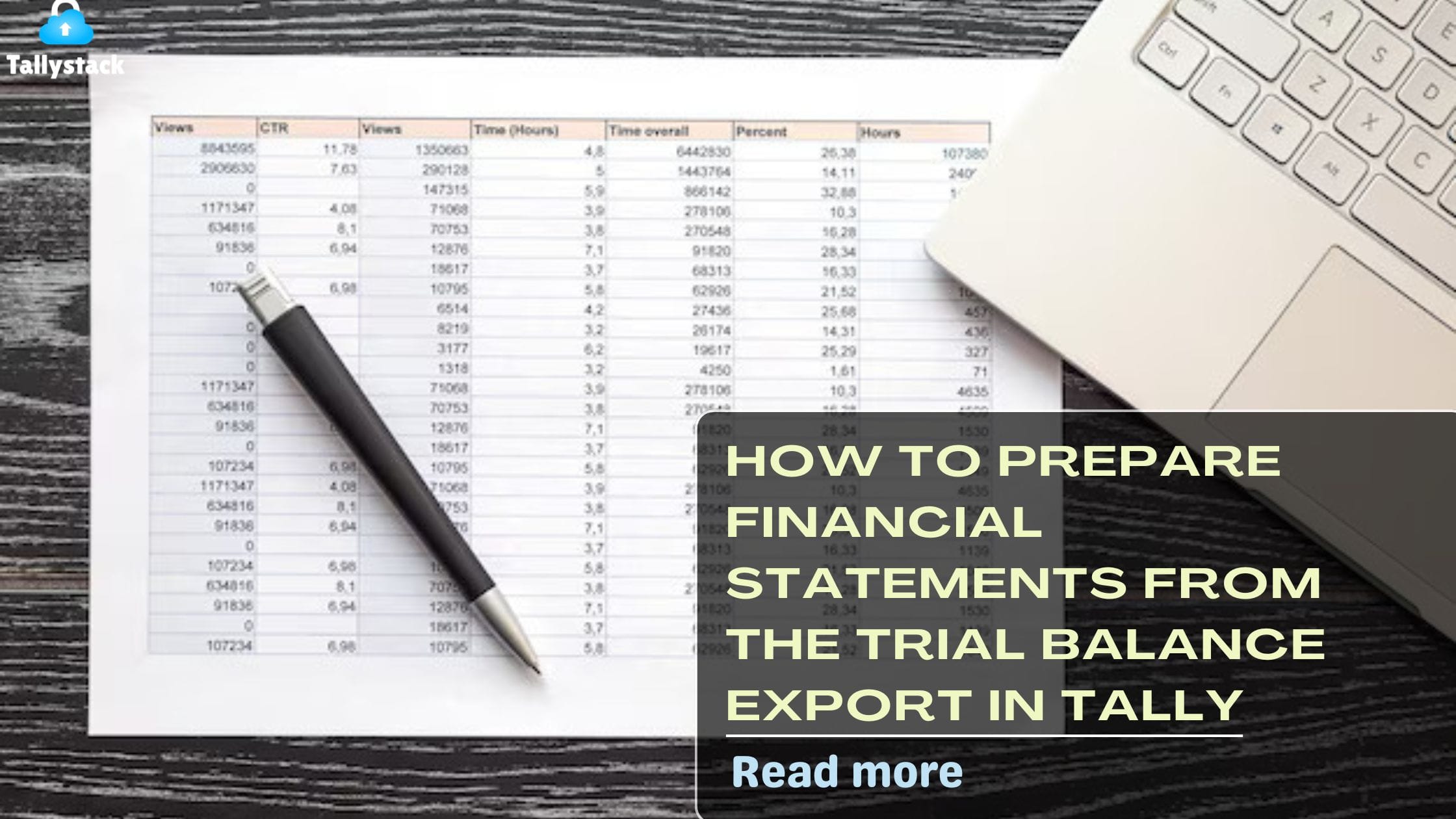
How to Prepare Financial Statements from the Trial Balance Export in Tally
Introduction
In today’s fast-paced financial environment, accurate financial statements are vital for any business. Using Tally’s powerful accounting software simplifies this process. If you’re wondering how to prepare financial statements from the Trial Balance export in Tally, this guide will walk you through the steps. Whether you use Tally Prime or older versions, the steps remain largely consistent, ensuring you can easily create accurate financial statements.
What Is a Trial Balance?
A Trial Balance is a report that lists all the general ledger balances in a business, organized into debit and credit columns. This ensures that the books are balanced, which is essential before preparing financial statements like the Profit and Loss Account, Balance Sheet, and Cash Flow Statement.
Importance of Financial Statements
- Legal Compliance: Businesses are required to prepare financial statements to comply with legal and tax regulations.
- Performance Insights: Financial statements provide insights into a business’s financial health.
- Decision-Making: Stakeholders rely on these statements to make informed decisions.
By using Tally’s Trial Balance export feature, you can streamline the creation of these statements with minimal effort.
Download Free 90+ Tally Shortcut Keys
Step-by-Step Guide to Export Trial Balance in Tally
Step 1: Open Your Company in Tally
Log in to your company file in Tally Prime or your specific Tally version. Ensure all transactions for the period are updated.
Step 2: Access the Trial Balance
Navigate to the Gateway of Tally > Display > Trial Balance. This screen shows the ledger accounts grouped under Assets, Liabilities, Income, and Expenses.
Step 3: Export the Trial Balance
- Press Alt + E or choose the Export option from the menu.
- Select the desired format (Excel, PDF, or CSV).
- Define the period for which the trial balance is needed.
Step 4: Verify the Exported Data
After exporting, open the file to ensure all figures are accurate and match your expectations. This step is crucial to avoid errors in your financial statements.

Preparing Financial Statements from Trial Balance
Once the Trial Balance is exported, follow these steps to prepare the three primary financial statements:
1. Profit and Loss Account
The Profit and Loss Account (P&L) summarizes a company’s revenues and expenses for a specific period.
Steps:
- From the exported Trial Balance, segregate income and expense accounts.
- Calculate the total revenue (credits) and total expenses (debits).
- Subtract total expenses from total revenue to determine the net profit or loss.
Example:
Total Revenue: ₹5,00,000
Total Expenses: ₹3,50,000
Net Profit = ₹5,00,000 – ₹3,50,000 = ₹1,50,000
2. Balance Sheet
The Balance Sheet provides a snapshot of a company’s financial position at a specific date.
Steps:
- Organize the Trial Balance accounts into Assets, Liabilities, and Equity.
- Ensure that the total of assets equals the sum of liabilities and equity (Assets = Liabilities + Equity).
Example:
Assets: ₹10,00,000
Liabilities: ₹6,00,000
Equity: ₹4,00,000
3. Cash Flow Statement
The Cash Flow Statement tracks the flow of cash into and out of the business during a specific period.
Steps:
- Identify cash-related accounts from the Trial Balance.
- Classify transactions under Operating Activities, Investing Activities, and Financing Activities.
- Calculate the net cash flow by summing up cash inflows and subtracting outflows.

Key Tips for Accuracy in Financial Statements
- Reconcile Accounts Regularly: Before exporting the Trial Balance, reconcile all accounts to ensure accuracy.
- Verify Adjustments: Make sure adjusting entries, such as depreciation or accrued expenses, are entered.
- Leverage Tally Features: Use Tally’s built-in audit tools to verify balances and detect discrepancies.
- Back Up Data: Always back up your Tally data to avoid data loss.
How Tally on Cloud Simplifies the Process
Using Tally on Cloud, such as the service provided by Tallystack, can make the financial statement preparation process even more seamless.
Benefits of Tally on Cloud:
- Anywhere Access: Work on your accounts from any device, anywhere.
- Enhanced Security: Protect sensitive financial data with 99.9% uptime and robust backup solutions.
- Cost-Effective: Reduce IT infrastructure costs by hosting Tally in the cloud.
- Team Collaboration: Multiple users can work simultaneously, improving efficiency.
By shifting to Tally on Cloud, businesses can save time and effort in preparing their financial reports.
Common Mistakes to Avoid
- Ignoring Trial Balance Discrepancies: Always resolve discrepancies before preparing financial statements.
- Skipping Adjustments: Not recording accruals or prepayments can lead to inaccurate financial statements.
- Inconsistent Data Export: Ensure that the Trial Balance period matches the reporting period.
Conclusion
Preparing financial statements from the Trial Balance export in Tally doesn’t have to be complex. By following the steps outlined above, businesses can create accurate Profit and Loss Accounts, Balance Sheets, and Cash Flow Statements with ease. Services like Tally on Cloud by Tallystack further enhance this process, offering accessibility and security. Take the time to verify your data, use Tally’s robust features, and ensure compliance with financial regulations for a seamless reporting experience.
Empower your business with smarter financial management using Tallystack’s Tally on Cloud services today!
Frequently Asked Questions
Q1: Can I prepare financial statements directly in Tally?
Yes, Tally allows you to generate automated financial reports, but exporting the Trial Balance provides flexibility for customized reporting.
Q2: What formats can I export the Trial Balance in?
Tally supports multiple formats, including Excel, PDF, and CSV.
Q3: Why is Tally on Cloud beneficial for financial reporting?
Tally on Cloud allows remote access, enhanced security, and collaborative capabilities, making it ideal for preparing financial reports efficiently.
